|

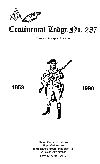
Welcome
to Continental Lodge #287's Home Page. We Fraternally invite you to
view our Communication and visit us on our regular meeting night. We
meet on the first Wednesday of the month at Grand Lodge, 71 West 23rd
Street in the Renaissance Room on the 6th Floor at 7:30PM. Our
Brothers meet for dinner prior to the meetings. Check the
Communication for location and feel free to join us..... Dutch of
course!!
Be Well, God Bless and let our Brotherly Love Spread Around the
World!!!
 |
|

 |
Sign Our GuestBook
View Our GuestBook |
| If you are not already a member
of our ancient & honorable fraternity, and would like additional
information, please contact this Lodg or any of our fraternity.
Although we cannot directly solicit members, we will be pleased to
respond to your interest by answering your questions and will gladly
provide a petition at your request. |
|


| |
 Home Home
| King
C Gillette
In 1895 King Camp Gillette was the salesman for the man who
invented cork-lined bottle caps. "Invent something people use and throw away,"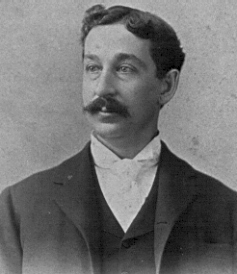 the man told him. It'd sure worked for him.
the man told him. It'd sure worked for him.
Gillette wondered what he might invent. It hit him one morning while he was shaving. He
thought up the safety razor, but he couldn't figure how to make good disposible blades.
For years he struggled. Finally he met William Nickerson.
Nickerson was a fine inventor. This was a fine challenge. Nickerson finally saw that he
could make the blade wide. He could let the holder bend it into position. Then he'd have
both accuracy and a sharp edge. Together, Gillette and Nickerson began making safety
razors in 1903.
The next question was what to name the thing. If they called a razor blade a Nickerson,
that was too suggestive of nicked skin. In the end Gillette's name attached to the
invention, and his face rode on the razor blade wrapper. Within a few years Gillette was a
millionaire.
Now that's only the first half of Gillette's story. Howard Mansfield tells the rest, and
it gets very interesting. The year before he cooked up the safety razor, Gillette
published a book on another idea entirely. It was terrifying and idealistic.
His Utopian socialistic world would be based on universal cooperation. All production
would be done efficiently by one great company with all people as shareholders.
"Selfishness would be unknown, and war would be a barbarism of the past," he
wrote.
He imagined all 60 million Americans living in one great Metropolis. It'd be powered by
the Niagara River. It'd have a hundred million rooms and be served by vast common dining
halls.
Before WW-I he tried to set up his World Corporation -- this time in the Arizona
Territory. He asked Teddy Roosevelt to be its president. When that failed, he turned to
social reformer and writer Sinclair Lewis. Lewis arranged a disastrous meeting between
Gillette and Henry Ford. The two millionaires talked past each other. Finally, they simply
shouted in anger.
Lewis also helped Gillette with his most cogent statement -- a book called The
People's Corporation. Even that was naive at best. Stuart Chase said that his
sincerity was deep and compelling. "... but his solution is quite untouched by the
realities which guard the road to Utopia."
In his last years Gillette tried to extract oil from shale. He still had his inventive
verve. But he carried his socialism to the grave. He didn't see that the simple elegance
of his safety razor was no match for the complexity of human affairs.
Return
to Last Page |
| James
Forten
James Forten was born of free African-American parents in Philadelphia on September 2,
1766. He studied at a Quaker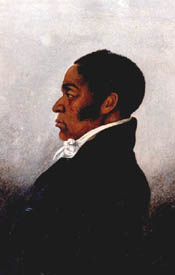 school but at the age of fifteen he quit to
serve as a powder boy aboard the privateer Royal Louis during the American Revolution. He
was captured by the British and held prisoner for seven months. He eventually spent a year
in England where he was introduced to abolitionist philosophy. school but at the age of fifteen he quit to
serve as a powder boy aboard the privateer Royal Louis during the American Revolution. He
was captured by the British and held prisoner for seven months. He eventually spent a year
in England where he was introduced to abolitionist philosophy.
Upon returning to America he was apprenticed to a sailmaker, but by 1786 he was foreman
and in 1798 he became owner of the company. The business prospered and in 1832 employed
forty white and African American workers.
By the 1830s Forten had become active in the abolitionist movement and was a strong
opponent of African colonization. He became a noted pamphleteer, a 19th-century form of
social activism and was an early fund-raiser for William Lloyd Garrison's The Liberator.
Forten was president and founder of the American Moral Reform Society and was active in
the American Anti-Slavery Society. He was a vigorous opponent of northern implementation
of the Fugitive Slave Act of 1793. Forten died in Philadelphia on March 4, 1842. Return
to Last Page |
Henry Ford
Henry
Ford, born on July 30, 1863, was the first of William and Mary Ford's six children. He
grew up on a pros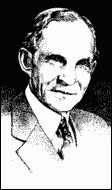 perous family farm in what
is today Dearborn, Michigan. Henry enjoyed a childhood typical of the rural nineteenth
century, spending days in a one-room school and doing farm chores. At an early age, he
showed an interest in mechanical things and a dislike for farm work. perous family farm in what
is today Dearborn, Michigan. Henry enjoyed a childhood typical of the rural nineteenth
century, spending days in a one-room school and doing farm chores. At an early age, he
showed an interest in mechanical things and a dislike for farm work.
In 1879, sixteen-year-old Ford left home for the nearby city of
Detroit to work as an apprentice machinist, although he occasionally returned to help on
the farm. He remained an apprentice for three years and then returned to Dearborn. During
the next few years, Henry divided his time between operating or repairing steam engines,
finding occasional work in a Detroit factory, and over-hauling his father's farm
implements, as well as lending a reluctant hand with other farm work. Upon his marriage to
Clara Bryant in 1888, Henry supported himself and his wife by running a sawmill.
Ford became an engineer with the Edison Illuminating Company in Detroit. This event
signified a conscious decision on Ford's part to dedicate his life to industrial pursuits.
His promotion to Chief Engineer in 1893 gave him enough time and money to devote attention
to his personal experiments on internal combustion engines.
These experiments culminated in 1896 with the completion of his own self-propelled
vehicle-the Quadricycle. The Quadricycle had four wire wheels that looked like heavy
bicycle wheels, was steered with a tiller like a boat, and had only two forward speeds
with no reverse. Although Ford was not the first to build a self-propelled vehicle with a
gasoline engine, he was, however, one of several automotive pioneers who helped this
country become a nation of motorists.
Ford Motor Company Incorporated and the Introduction of the Model TAfter two unsuccessful
attempts to establish a company to manufacture automobiles, the Ford Motor Company was
incorporated in 1903 with Henry Ford as vice-president and chief engineer. The infant
company produced only a few cars a day at the Ford factory on Mack Avenue in Detroit.
Groups of two or three men worked on each car from components made to order by other
companies.
Henry Ford realized his dream of producing an automobile that was reasonably priced,
reliable, and efficient with the introduction of the Model T in 1908. This vehicle
initiated a new era in personal transportation. It was easy to operate, maintain, and
handle on rough roads, immediately becoming a huge success. By 1918, half of all cars in
America were Model Ts. To meet the growing demand for the Model T, the company opened a
large factory at Highland Park, Michigan, in 1910. Here, Henry Ford combined precision
manufacturing, standardized and interchangeable parts, a division of labor, and, in 1913,
a continuous moving assembly line. Workers remained in place, adding one component to each
automobile as it moved past them on the line. Delivery of parts by conveyor belt to the
workers was carefully timed to keep the assembly line moving smoothly and efficiently. The
introduction of the moving assembly line revolutionized automobile production by
significantly reducing assembly time per vehicle, thus lowering costs. Ford's production
of Model Ts made his company the largest automobile manufacturer in the world.
The company began construction of the world's largest industrial complex along the banks
of the Rouge River in Dearborn, Michigan, during the late 1910s and early 1920s. The
massive Rouge Plant included all the elements needed for automobile production: a steel
mill, glass factory, and automobile assembly line. Iron ore and coal were brought in on
Great Lakes steamers and by railroad, and were used to produce both iron and steel.
Rolling mills, forges, and assembly shops transformed the steel into springs, axles, and
car bodies. Foundries converted iron into engine blocks and cylinder heads that were
assembled with other components into engines. By September 1927, all steps in the
manufacturing process from refining raw materials to final assembly of the automobile took
place at the vast Rouge Plant, characterizing Henry Ford's idea of mass production. Return
to Last Page |
| "Edwin
L Drake"
"Father" of the petroleum industry, born in Greenville, New York; he spent
his boyhood in Castleton Corners and attended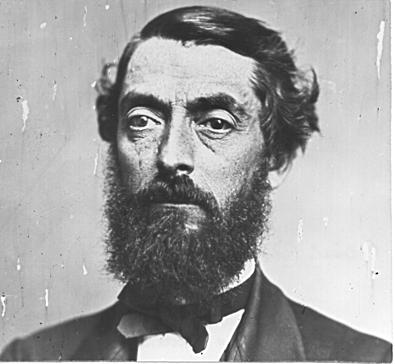 local schools. local schools.
Drake worked a succession of jobs in the Midwest and East after leaving the family farm at
age 19, ending up as a conductor for the New York & New Haven Railroad (1850-57). In
the late 1850s he bought stock in George Bissell's Pennsylvania Rock Oil Company, and in
1857 (taking advantage of his conductor's job to travel free) he traveled to see the land
near Oil Creek (Titusville), Pennsylvania, where surface oil was being collected.
Having observed the drilling of artesian wells in New York and Pennsylvania, he shared
Bissell's idea of borrowing from that technology to drill for oil in Titusville. The
Seneca Oil Company was formed with now "Colonel" Drake as president. He secured
a lease and began experimenting in 1858, striking oil at 69 feet on August 27, 1859,
effectively the first true oil well.
He neglected to patent his drilling invention, a pipe liner for the drill hole, and proved
to be a poor businessman, losing his savings to oil speculation in New York City (1863).
He drifted for several years, returning to Pennsylvania in 1870 ill and impoverished. The
citizens of Titusville collected some money for him and he was voted an annuity by the
state legislature in 1876.
Drake had given birth to an industry which would dominate the 20th century, but would die
a pauper.
Return
to Last Page |
| Walter
P Chrysler
Walter Chrysler was born on April 2, 1875 in Winnebago, Kansas, a
railway town where his father worked as an  engineer with the Union Pacific Railroad. A few years later, the Chrysler family
moved to Ellis, Kansas. Ellis was yet another railway town, where Walter spent his spare
time in locomotive shops watching repairmen at work and occasionally working with them. At
the age of 18 he constructed a fully detailed, model steam locomotive and ran it on a rail
track he constructed. Chrysler became a master mechanic and in 1908 a Superintendent of
10, 000 workers at Chicago & Great Western Railroad. engineer with the Union Pacific Railroad. A few years later, the Chrysler family
moved to Ellis, Kansas. Ellis was yet another railway town, where Walter spent his spare
time in locomotive shops watching repairmen at work and occasionally working with them. At
the age of 18 he constructed a fully detailed, model steam locomotive and ran it on a rail
track he constructed. Chrysler became a master mechanic and in 1908 a Superintendent of
10, 000 workers at Chicago & Great Western Railroad.
It was at an auto show in Chicago in 1908 that Walter Chrysler saw the
future when he first spotted a Locomobile Phaeton. He decided to combine his meager
savings with a $4,300 loan to purchase the vehicle. Most people now in his position might
have taken the new automobile for a cruise around the city. But Walter Chrysler was not
interested in showing off his new toy. Instead, Chrysler spent his spare time taking the
automobile apart, studying it, and rebuilding it. He was instantly hooked and decided to
take a 50% pay cut in 1912 and switch careers..... He was going to break into the
automobile industry.
A decade and a half after laying his eyes on the Locomobile Phaeton,
Walter Chrysler launched the Chrysler Corporation in spectacular fashion during the New
York Auto Show. The Chrysler Six Phaeton made the most stunning debut in automotive
history at that time - selling 32,000 units its first year.
The Chrysler Corporation became the second largest U.S. automaker during
the 1930s. By this time Chrysler was a self-made millionaire and began turning his
attention to other activities, including financing and helping design the Chrysler
building in New York City. He resigned from the Chrysler Corporation in 1935, at age 60,
and died August 18, 1940.
Return to Last Page |
Lloyd
Blafour
Lloyd G. Balfour was born in Wauseon, Ohio; attended public schools in
Louisville, Kentucky; graduated from the University of Louisville and Indiana University Law School; and following brief
careers in the fields of law and sales, he came to Attleboro, Massachusetts with the
specific intent of founding a jewelry company that would have high standards for
excellence of product and quality of its personnel. Mildred McCann Balfour grew up in
North Attleboro, Massachusetts and studied at the University of Illinois. Lloyd and
Mildred met around 1918 and they were married in 1921. Together they worked to build the
L. G. Balfour Company into the giant that it became. of Louisville and Indiana University Law School; and following brief
careers in the fields of law and sales, he came to Attleboro, Massachusetts with the
specific intent of founding a jewelry company that would have high standards for
excellence of product and quality of its personnel. Mildred McCann Balfour grew up in
North Attleboro, Massachusetts and studied at the University of Illinois. Lloyd and
Mildred met around 1918 and they were married in 1921. Together they worked to build the
L. G. Balfour Company into the giant that it became.
The Balfours lived in a log cabin on a working farm. Their home, located on Pine Street in
Norton, was the scene of many gatherings of friends and associates.
There was another side to the Balfours, one that was rigorously safe guarded. They
participated in many philanthropic deeds but with little fanfare. They were generous to
many schools and hospitals; to many local students who could not have attended college
without this support; and to distressed families needing support over the rough spots.
Lloyd Balfour died at his home on July 11, 1973, at the age of 87. Mildred survived him by
a decade. Under the terms of his will, the L. G. Balfour Foundation, was founded. It is
designed to help support the causes that Lloyd and Mildred supported during their
lifetimes.
The people of the Town of Norton are grateful for the Balfour Foundation grant that has
helped them to finance their new library building. The citizens of Norton will be ever
mindful of the generosity of this fine couple. Return
to Last Page |
Return To Home Page
|
